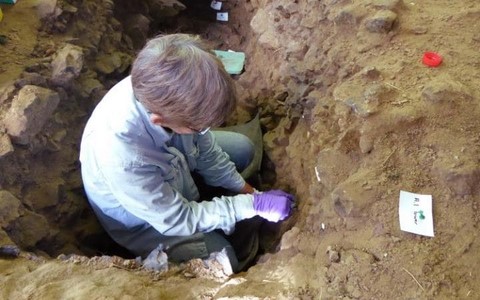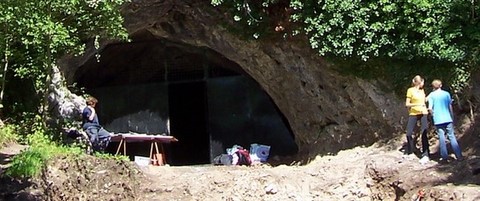Early human DNA found widely - and not in bones!
Fifty thousand years ago, a Neandertal relieved himself in a cave in present-day Belgium, depositing, among other things, a sample of his DNA. The urine clung to minerals in the soil and the feces eventually decomposed. But traces of the DNA remained, embedded in the cave floor, where earth falling from the cave’s ceiling and blowing in from outside eventually entombed it. Now, researchers have shown they can find and identify such genetic traces of both Neandertals and Denisovans, another type of archaic human, enabling them to test for the presence of ancient humans even in sites where no bones have been found.
“It’s a great breakthrough,” says Chris Stringer, an anthropologist at the Natural History Museum in London. “Anyone who’s digging cave sites from the Pleistocene now should put [screening sediments for human DNA] on their list of things that they must do.” Adds Svante Pääbo, the head of the Max Planck Institute for Evolutionary Anthropology in Leipzig, Germany, where the work was done: “I think this will become a standard tool in archaeology, maybe even like radiocarbon dating.”
Scientists have known that DNA can survive in ancient sediments since 2003, when Eske Willerslev, an evolutionary geneticist at the University of Copenhagen, sequenced the DNA of mammoths, horses, and 19 plant taxa from cores drawn from Siberian permafrost and temperate caves. But at the time, Willerslev recalls, he had no way of distinguishing ancient human sequences from the modern ones that can contaminate samples as they are handled. Since then, techniques for filtering out such contamination have improved, which encouraged Max Planck geneticist Matthias Meyer to try to sieve out human DNA from sediments in once-occupied caves.
When Meyer and Max Planck doctoral student Viviane Slon first sequenced environmental DNA from Pleistocene cave sediments around Europe, the data overwhelmed them. “It’s on the order of trillions of DNA fragments in a sample the size of a teaspoon,” Meyer says. Only a tiny fraction of those fragments might belong to ancient humans. To capture them, the researchers developed a delicate DNA hook, crafted from modern human DNA from the mitochondria, the tiny power plants that produce energy for cells. The molecular hook fished out the sequences that most resembled it, which Meyer and Slon then compared to known mitochondrial DNA (mtDNA) sequences from Neandertals and Denisovans. They looked for mtDNA because it is much more abundant than nuclear DNA, with thousands of copies per cell.
The pair worried that human DNA would be so scarce that even their careful fishing would fail to find it. “My jaw dropped,” Slon said, at the sight of the first Neandertal sequences. She and Meyer detected Neandertal DNA in sediment from four of seven cave sites, ranging from Spain to Russia, where archaic humans were known to have lived, they report in a story published online today. They also found Denisovan DNA from sediment in Denisova Cave, the Siberian site containing the only known Denisovan bones. There, both Neandertal and Denisovan DNA emerged from layers where no bones had been found, pushing back the period of human occupation by tens of thousands of years. Meyer and Slon even managed to find Neandertal DNA in Belgium’s Trou Al’Wesse Cave, which contains no Neandertal bones at all—only characteristic stone tools.
Meyer and Slon also analyzed the DNA of other mammals known to have inhabited the caves, based on bones found there. The DNA and bones told the same story about when and where the animals were present, giving the researchers confidence that chronologies derived from soil DNA are reliable.
“I’m so happy to see the field move in this direction,” says Hendrik Poinar, head of the ancient DNA lab at McMaster University in Hamilton, Canada. Several researchers say ancient DNA from sediments will help them complete the map of ancient human occupations and allow them to see where species may have overlapped and interacted. That’s important because bones of humans are extremely rare. For example, ancient human DNA might have strengthened the controversial claim this week of the oldest human presence in the Americas.
“If one must rely on finding bones, one will always have incomplete data,” says Beth Shapiro, an evolutionary biologist at the University of California, Santa Cruz. “By isolating DNA directly from sediments, we can dramatically expand what we know about where people were, when they got there, and how long they stayed.” This could be particularly important for the Denisovans, identified so far only from one cave. Genetic traces lingering in living people suggest that this archaic species must once have lived across Asia. But researchers don’t know exactly where, or when.
Stringer suspects ancient human DNA from sediments could also help resolve whether certain controversial stone tool technologies, such as the Uluzzian found in Italy, were made by modern humans or Neandertals. It could even reveal the existence of ancient human species that scientists don’t yet know about, he says. “What else is out there?”
The article in The Telegraph
International scientists have uncovered prehistoric human DNA of two extinct human relatives - the Neanderthals, and the Denisovans- from caves without bones, an advance that could shed new light on human history and evolution.
The technique could be valuable for reconstructing human evolutionary history, according to the study published on Thursday in the journal Science.
That's because fossilised bones, currently the main source of ancient DNA, are scarce even at sites where circumstantial evidence points to a prehistoric human presence.
"There are many caves where stone tools are found but no bones," said Matthias Meyer, a geneticist at the Max Planck Institute for Evolutionary Anthropology in Leipzig, Germany, who co-authored the study.
The researchers collected 85 sediment samples from seven caves in Europe and Russia that humans are known to have entered or even lived during the Pleistocene, between 14,000 and 550,000 years ago.
By refining a method previously used to find plant and animal DNA, they were able to search specifically for genetic material belonging to ancient humans and other mammals.
"This work represents an enormous scientific breakthrough," said Antonio Rosas, scientist at Spain's Natural Science Museum in Madrid.
"We can now tell which species of hominid occupied a cave and on which particular stratigraphic level, even when no bone or skeletal remains are present."
Scientists focused on mitochondrial DNA, which is passed down the maternal line, because it is particularly suited to telling apart closely related species. By analysing damaged molecules they were able to separate ancient genetic material from any contamination left behind by modern visitors
"The technique could increase the sample size of the Neanderthal and Denisovan mitochondrial genomes, which until now were limited by the number of preserved remains," explained Spanish National Research Council scientist Carles Lalueza-Fox.
"And it will probably be possible to even recover substantial parts of nuclear genomes."
The researchers found evidence of 12 mammal families including extinct species such as woolly mammoth, woolly rhinoceros, cave bear and cave hyena.
By further enriching the samples for human-like DNA, however, the scientists were able to detect genetic traces of Denisovans - a mysterious lineage of ancient humans first discovered in a cave in Siberia - and Neanderthals from samples taken at four sites.
Crucially, one of the sites where they discovered Neanderthal DNA was a cave in Belgium, known as Trou Al'Wesse, where no human bones had ever been found, though stone artifacts and animal bones with cut marks strongly suggested people had visited it.
Eske Willerslev, who helped pioneer the search for DNA in sediment but wasn't involved in the latest research, said the new study was an interesting step, but cautioned that it's difficult to determine how old sediment samples found in caves are.
"In general (it) is very disturbed and unless you can show that's not the case you have no idea of the date of the findings," said Mr Willerslev, an evolutionary geneticist at the University of Copenhagen, Denmark.
Mr Meyer said the new method greatly increases the number of sites where archaeologists will be able to find genetic evidence to help fill gaps in the history of human evolution and migration, such as how widespread Neanderthal populations were and which stone tools they were able to make.
Scientists may also be able to greatly expand their limited knowledge of the Denisovans, the recently discovered sub-species of the human family whose DNA can still be found in Melanesians and Aboriginal Australians today, by using the new procedure.
"In principle, every cave where there's evidence of human activity now offers this possibility," Mr Meyer told The Associated Press.
x



